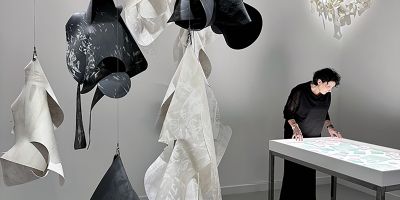Sound-making tech developed by PCI researcher inspires older people to move more

The echome technology creates sounds responding to users’ movements in real time
Older people are moving more, in playful and surprising ways, after using wearable technology developed by a researcher at the University of Leeds’ School of Performance and Cultural Industries.
In partnership with Age UK Leeds, Dr Maria Kapsali, Associate Professor in Physical Performance in the School of Performance and Cultural Industries, supplied a group of five adults aged 60-80 with echome – a box linked to a wearable sensor that creates sounds responding to users’ movements in real time.

The project, which was funded by a Research England grant, had some unexpected results as participants used the device in innovative ways. 82-year-old Colin (pictured) connected the echome box to his scooter and rode around his neighbourhood creating a live soundtrack, and Kath, aged 61, attached the echome sensor to her wrist while engaging in creative writing to inspire her poetry.
Many of our older people at Age UK Leeds have found that echome encourages them to be creative with sound while moving.
Dr Kapsali said: "The project with Age UK has had some really surprising results. We've seen the echome device helping older people express themselves and connect with their community, improving social interaction and confidence, as well as encouraging more movement."
'It almost tricks you into doing exercise’
Colin, 82, who attached the echome to his scooter and rode to his local shop, said: “It makes me feel better, and knowing I’m actually moving is doing me good. Movement helps you relax and it helps to make you tired and sleep. When you hear a sound, you want to do a bit more and experiment with it and see what other things you can do.”
I can’t do exercise where you’ve got to move certain ways because of pain, but with echome I can do anything because it’s not as restrictive.
The project also gave the echome box to couple Ron and Andrea, both aged 78, setting up the technology so both of them could create sounds simultaneously using the same box.
Andrea, 78, who has limited mobility due to arthritis, said: “I have a great hang-up about not being able to move about and it’s got worse as I’ve got worse.
“I can’t do exercise where you’ve got to move certain ways because of pain, but with echome I can do anything because it’s not as restrictive. I can do it to the best of my ability without feeling guilty.”
Andrea’s partner Ron, 78, uses the device while he’s gardening. He said: “We noticed using the echome devices that you feel more tired after using these than a normal exercise session – it almost tricks you into doing exercise!”
Sparking creativity
Kath, 61, has used the echome for 10 minutes a day of free writing. She said: “I love it – I think it’s brilliant. It’s kept me writing ten minutes a day for about three weeks... It also reminds me to move which is a good thing.”
Sam Coates, Ways to Wellbeing Co-ordinator at Age UK Leeds, said: “Many of our older people at Age UK Leeds have found that echome encourages them to be creative with sound while moving. It offers a therapeutic and holistic approach for keeping mobile, whether this be within a group setting or in the comfort of their own home.
“echome continues to grow from strength to strength, helping people move comfortably, make music and discover their hidden talent once again.
“It has been an honour to work alongside Maria Kapsali. Age UK Leeds can see the undeniable benefits that echome has to offer.”
Sound and movement interaction: how it works

The echome sensor attaches to any part of the body and custom-made software converts movements into sounds through a box with a built-in Raspberry-Pi computer.
Some of the settings create the sounds of acoustic instruments, where others are based on everyday sounds and field recordings like birdsong. For example, circling your arm might make a flourishing piano sound that repeats, but if you moved your arm to the side the notes and rhythm might change.
The system was developed by Maria Kapsali, Kingsley Ash and Nikos Stavropoulos in collaboration with dance artists Sophie Alder and Sandrine Monin, industry professionals, and diverse groups of end-users.
Now that the Age UK project has concluded, the Leeds branch will keep the four echome boxes to be used with clients across the city.
The echome project has also received funding from the Cultural Institute’s Ignite Fund. Collaborating with Yorkshire Dance, this new strand will provide training for dance artists to work with echome in care homes.
Further information
Top image: 82-year-old Colin uses the echome device with his mobility scooter in his garden. Credit: Echome project, University of Leeds.
Dr Maria Kapsali and the project participants are all available for interviews. For media enquiries, please contact Mia Saunders in the University of Leeds press office on m.saunders@leeds.ac.uk.



